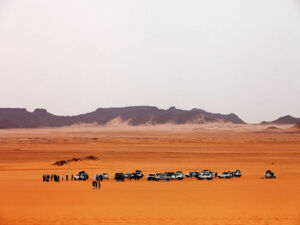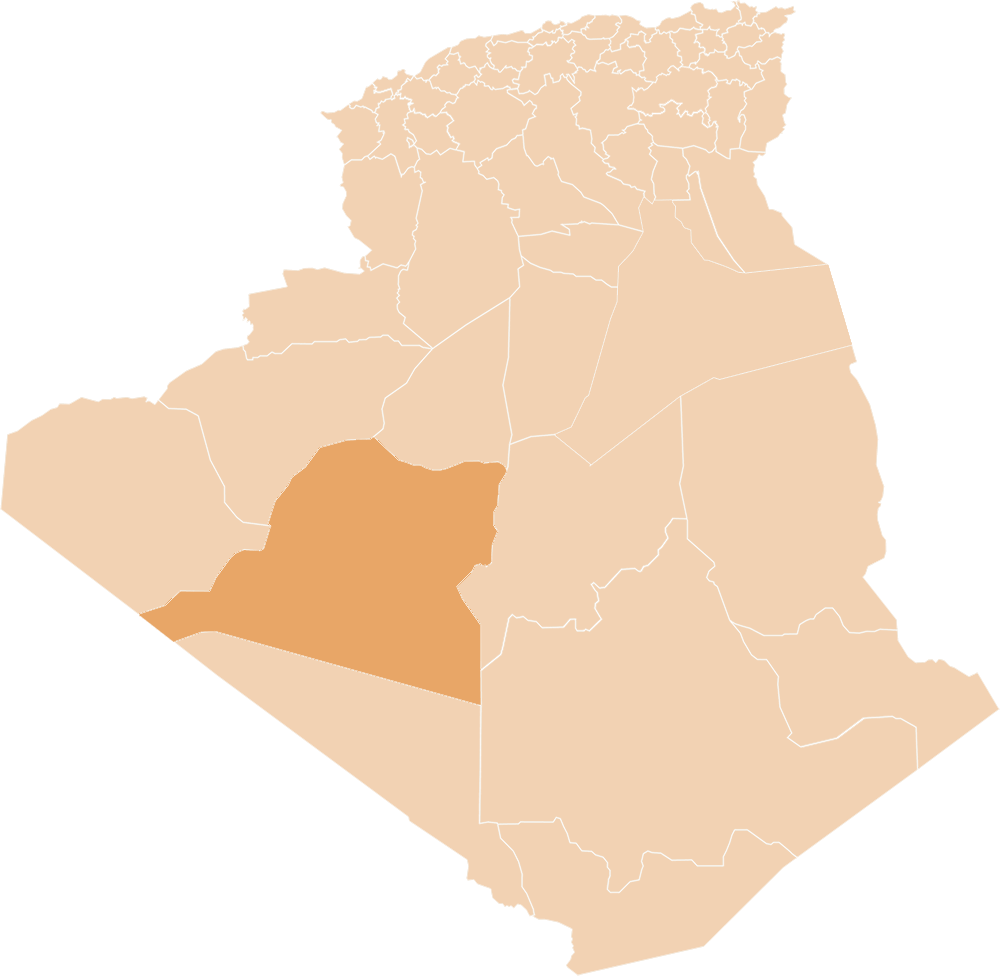Presentation of the province
At first glance, the word “Tamanrasset” awake inour mind an extraordinary picture painted on therocks and the sand. At dawn, when the first lightof the sun shines on the A skrem, it illuminatesa path that leads to a world rich of natural andcultural treasures. History and geography haveadorned Tamanrasset of its finest splendors. Theyshaped its unique beauty through many benefitsthat deserve discovery.
Historical overview
 Tamanrasset is strongly rooted in history.In this place, primitive man has built
Tamanrasset is strongly rooted in history.In this place, primitive man has builtits first civilization. He lived next to wildanimals (ostriches, giraffes and elephants)in the great Sahara, which was more likea Savannah, during the modern Stone Age(9000 and 2500 AD). The existence of water has led to the emergence of fish, crocodilesand hippos. Before it became arid aswe know it today, hunters and shepherdsbuilt, there, tents and houses. Drawingsand rock paintings reveal the characteristicsof those times. These works also show the
practices of local inhabitants during periodsof adaptation to their environment, the acquisitionof new tools and the appearanceof social customs. Tamanrasset caught theattention of several ethnic groups. First, itwas the place of residence of the Berbers(Touaregs). And then, when the Romansbecame stable in North Africa, a very dynamicactivity occurred. The place becamean essential commercial pole and a meetingpoint for trade caravans coming from Romeand Black Africa. During the 7th and 8thcentury AD, Islam is established in the region. Tamanrasset was inhabited by severaltribes. The development of trade led to anintermingling of cultures and customs.During the French occupation, Tamanrasset became a bastion of national resistanceand opposed both military campaigns andforeign religious missions. The resistancebegot several battles until the total occupationof the country. During the AlgerianRevolution and despite the attempts ofFrench colonialism to isolate the Saharafrom the Revolution, far to in the North, the Moujahidine of Tamanrasset joinedthe fight by setting up a number of majormilitary operations against the French occupiers.A lot of martyrs fell in battle andcemented the national unity with theirblood. The heroic acts of resistance multipliedand only ceased on Independencein 1962.
Geographical location
Under the 1974 administrative division, Tamanrasset was promoted province(Wilaya). It is located at the DeepSouth of Algeria at a distance of over2,000 km from the capital Algier
Access routes
Tamanrasset has a dual road network:a province road network and nationalone. Tamanrasset has many groundtran sport stations and A guenar international
Airport which provides tovisitors and tourists national and internationalflights that meet internationalsafety and comfort standards.
Climate
Extreme cold and maximum heat characterizethe Saharan climate of Tamanrasset. Temperate seasons have, in 13°C afternoon; in summer, duringthe same time, a 29° C temperature canbe recorded. Tropicaland summer rains fall during themonths of August and September
Natural environment
Tamanrasset ’s natural environment iscomposed as follows:
The plains:
They encompass theplains of Ahaggaroueds, Amdrour, Tanezrouft, Teneri and theplain of Tamanrasset.
- The isolated massifs:
These areformed by Inziza volcanic plains rangingfrom Tamanrasset to Djanet as well asthe Ifoughas massifs in the area of Tin Zaouatine
Flora and fauna
Tamanrasset flora is characterized by its diversity. It counts hundreds of vegetalspecies of Saharan, African and tropical origin. Among them, plantsthat have pastoral characteristics, those used for therapeutic purposes andothers for aesthetics. Finally, other plants are used in the field of housing construction and crafts. We will cite among others: Acacia, Artemisia, gumtree, jujube and Tamaris… As for fauna, Gazelles, Cheetahs, Moufflons,Vipers, Amphibians, in addition to fish like Barbels, Tilapia and Silurus.



